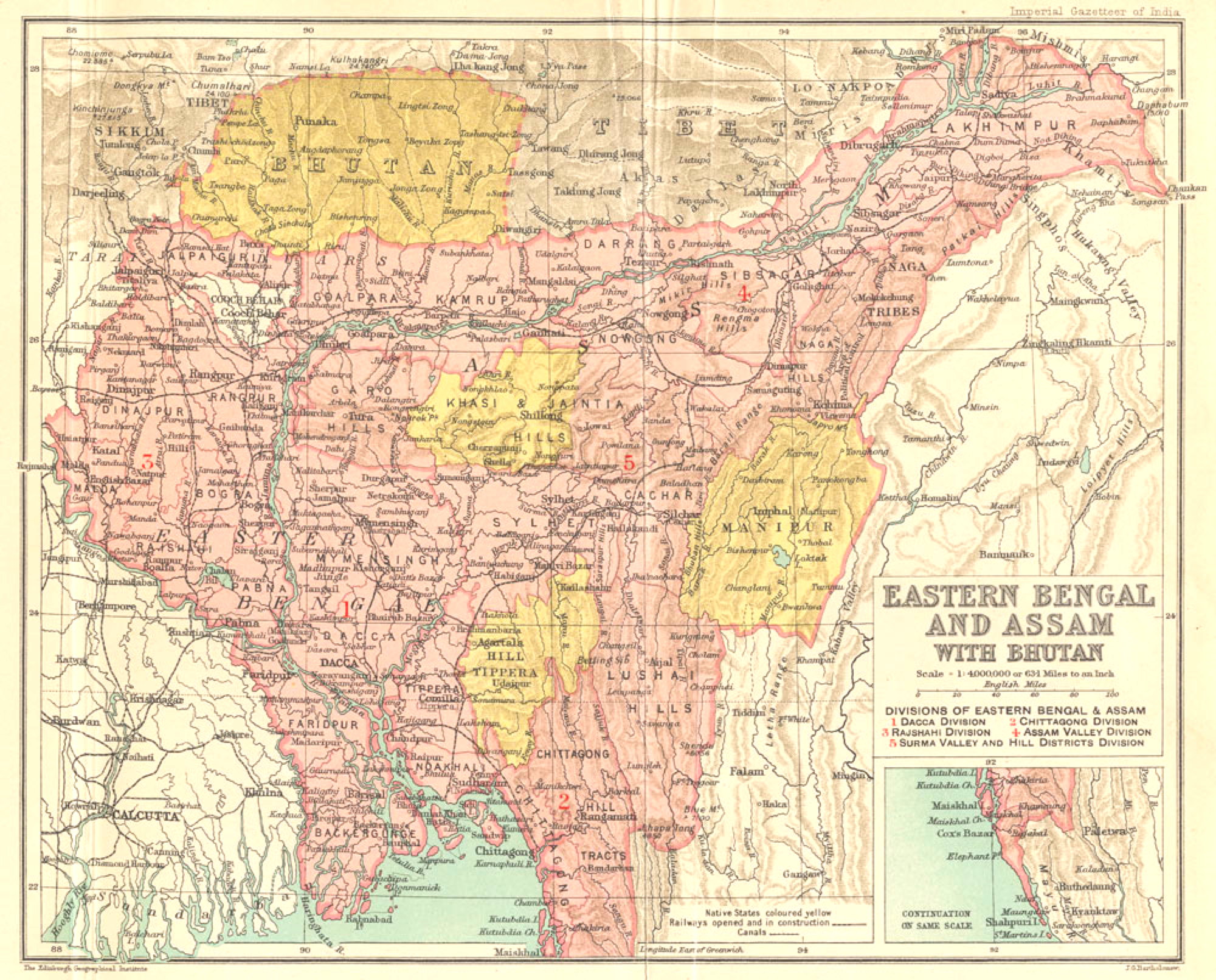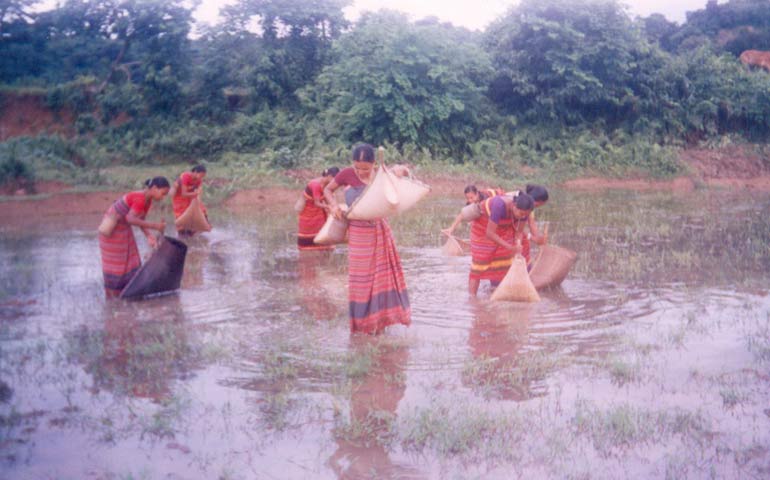|
Ampati
Ampati is a district headquarters of South West Garo Hills of Meghalaya state in north-eastern India. South West Garo Hills is curved of present West Garo Hills on 7 August 2012. It is located at the latitude of 25º27.505 and longitude of 089º56.456 and is 52 km away from the district headquarters Tura of West Garo Hills district, Meghalaya. The hill region is mostly inhabited by the Garos, while in the foothills there are Hajongs and Koches. The second largest ethnicity after Garos is Hajong. The district is surrounded by South Salmara district of Assam and Kurigram District of Bangladesh. South West Garo Hills has approximately 35 kilometres of international boundary with Bangladesh on the south and western side. Nearly one third of the total number of villages of the district is declared as border villages by the Border Area Development Department. Population The total population of South West Garo Hills is 1,72,495District Statistical Office, West Garo Hills, Tura ... [...More Info...] [...Related Items...] OR: [Wikipedia] [Google] [Baidu] |
South West Garo Hills
Southwest Garo Hills is an administrative district in the State of Meghalaya, India. The Ampati Civil Sub-Division is upgraded to a full fledged district as South West Garo Hills, on 7 August 2012 with its headquarters at Ampati. It was inaugurated by Dr. Mukul Sangma, Hon'ble Chief Minister of Meghalaya, India. History and Creation The South West Garo Hills is carved out of present West Garo Hills, Meghalaya, India. The District comprises all the villages falling under the two Community and Rural Development Blocks, viz. Betasing and Zikzak Community and Rural Development Blocks, including 33 (thirty-three) villages under Mukdangra Gram Sevak (GS) Circle and Garobadha Gram Sevak Circle of Selsella Community & Rural Development Block, 24 (twenty-four) villages under Okkapara Songma Gram Sevak Circle and Chengkuregre Gram Sevak Circle of Gambeggre Community & Rural Development Block, 13 (thirteen) villages under Jarangkona Gram Sevak Circle of Dalu Community & Rural Developme ... [...More Info...] [...Related Items...] OR: [Wikipedia] [Google] [Baidu] |
Meghalaya
Meghalaya (, or , meaning "abode of clouds"; from Sanskrit , "cloud" + , "abode") is a state in northeastern India. Meghalaya was formed on 21 January 1972 by carving out two districts from the state of Assam: (a) the United Khasi Hills and Jaintia Hills and (b) the Garo Hills.History of Meghalaya State Government of India Meghalaya was previously part of Assam, but on 21 January 1972, the districts of Khasi, Garo and Jaintia Hills became the new state of Meghalaya. The population of Meghalaya as of 2014 is estimated to be 3,211,474. Meghalaya covers an area of approximately 22,430 square kilometres, with a length-to-breadth ratio of about 3:1.Meghalaya IBEF, India (2013) T ... [...More Info...] [...Related Items...] OR: [Wikipedia] [Google] [Baidu] |
List Of Districts Of India
A district (''Zila (country subdivision), zila'') is an administrative division of an States and union territories of India, Indian state or territory. In some cases, districts are further subdivided into sub-divisions, and in others directly into tehsil, ''tehsils'' or ''talukas''. , there are a total of 766 districts, up from the 640 in the 2011 Census of India and the 593 recorded in the 2001 Census of India. District officials include: *District magistrate (India), District Magistrate or Deputy Commissioner or District Collector, an officer of the Indian Administrative Service, in charge of Public administration, administration and revenue collection *Superintendent of Police (India), Superintendent of Police or Senior Superintendent of Police or Deputy Commissioner of Police, an officer belonging to the Indian Police Service, responsible for maintaining Law and order (politics), law and order *Deputy Conservator of Forests, an officer belonging to the Indian Forest Service ... [...More Info...] [...Related Items...] OR: [Wikipedia] [Google] [Baidu] |
Betasing
Betasing is the Community & Rural Development Block headquarters situated 7 km from the district headquarters of South West Garo Hills, Ampati. Demographics Betasing Block of South West Garo Hills has a total population of 72,103 as per the census of 2011. Out of which 36,340 are males and 35763 are females. Religion About 45,545 of the people follow Christianity while 20,181 follow Hinduism. Unaffiliated and other religions make up the rest of the population. Languages About 92% of the population are Tribals. Hajong, Garo and Koch Koch may refer to: People * Koch (surname), people with this surname * Koch dynasty, a dynasty in Assam and Bengal, north east India * Koch family * Koch people (or Koche), an ethnic group originally from the ancient Koch kingdom in north east ... are the major tribes in the Community and Rural Development Block. References {{Reflist South West Garo Hills district Cities and towns in South West Garo Hills district ... [...More Info...] [...Related Items...] OR: [Wikipedia] [Google] [Baidu] |
WikiProject Indian Cities
A WikiProject, or Wikiproject, is a Wikimedia movement affinity group for contributors with shared goals. WikiProjects are prevalent within the largest wiki, Wikipedia, and exist to varying degrees within sister projects such as Wiktionary, Wikiquote, Wikidata, and Wikisource. They also exist in different languages, and translation of articles is a form of their collaboration. During the COVID-19 pandemic, CBS News noted the role of Wikipedia's WikiProject Medicine in maintaining the accuracy of articles related to the disease. Another WikiProject that has drawn attention is WikiProject Women Scientists, which was profiled by '' Smithsonian'' for its efforts to improve coverage of women scientists which the profile noted had "helped increase the number of female scientists on Wikipedia from around 1,600 to over 5,000". On Wikipedia Some Wikipedia WikiProjects are substantial enough to engage in cooperative activities with outside organizations relevant to the field at issue. ... [...More Info...] [...Related Items...] OR: [Wikipedia] [Google] [Baidu] |
Assam
Assam (; ) is a state in northeastern India, south of the eastern Himalayas along the Brahmaputra and Barak River valleys. Assam covers an area of . The state is bordered by Bhutan and Arunachal Pradesh to the north; Nagaland and Manipur to the east; Meghalaya, Tripura, Mizoram and Bangladesh to the south; and West Bengal to the west via the Siliguri Corridor, a wide strip of land that connects the state to the rest of India. Assamese language, Assamese and Boro language (India), Boro are the official languages of Assam, while Bengali language, Bengali is an additional official language in the Barak Valley. Assam is known for Assam tea and Assam silk. The state was the first site for Oil well, oil drilling in Asia. Assam is home to the one-horned Indian rhinoceros, along with the wild water buffalo, pygmy hog, tiger and various species of Asiatic birds, and provides one of the last wild habitats for the Asian elephant. The Economy of Assam, Assamese economy is aided by w ... [...More Info...] [...Related Items...] OR: [Wikipedia] [Google] [Baidu] |
Hajong People
The Hajong people are an ethnic group from Northeast India and northern parts of Bangladesh. The majority of the Hajongs are settled in India and are predominantly rice-farmers. They are said to have brought wet-field cultivation to Garo Hills, where the Garo people used slash and burn method of agriculture.Ahmad, S., A. Kim, S. Kim, and M. Sangma. (2005). ''The Hajong of Bangladesh: A sociolinguistic survey.'' http://www.sil.org/resources/publications/entry/42943. Hajong have the status of a Scheduled Tribe in India and they are the fourth largest tribal ethnicity in the Indian state of Meghalaya. Origin The Hajongs belong to the Bodo-Kachari group of tribes, whose ancestors migrated from Tibet to the Brahmaputra Valley in the ancient past, from where they spread in multiple directions. The Hajongs have no recorded history and whatever historical references available are in the form of legends, folktales and traditional beliefs. The Hajongs believe that their ancestral land ... [...More Info...] [...Related Items...] OR: [Wikipedia] [Google] [Baidu] |
Koch People
The Koch are a small trans-border ethnic group of Assam and Meghalaya in India and northern Bangladesh. The group consists of nine matrilineal and strictly exogamous clans, with some of them preserving a hitherto sparsely documented Boro-Garo language called Koch, whereas others have switched to local varieties of Indo-Aryan languages. It is a Scheduled Tribe in Meghalaya, India. Koches want to preserve language and culture and heritage. The Koch people in this group are those who have preserved their languages, their animistic religions and follow non-Hindu customs and traditions. They are related but distinguished from the empire building Koch (the Rajbongshi people) and the Hindu caste called Koch in Upper Assam which receives converts from different tribes. Etymology of ''Koch'' According to Tabaqat-i-Nasiri, western Kamrud (Kamrup) was inhabited by the ''Koch'', ''Mech'' & '' Tharu''. In Yogini Tantra, Koches were called as Kuvachas. According to the Fatiyah-i-Ibriah ... [...More Info...] [...Related Items...] OR: [Wikipedia] [Google] [Baidu] |
South Salmara District
South Salmara Mankachar is an administrative district in the state of Assam in India. The district headquarter is located at Hatsingimari village which is situated at about 245 km from Guwahati. It was earlier a sub-division of the Dhubri District. History South Salmara Mankachar was created by bifurcating Old Dhubri district in 2016. On 15 August 2015 Assam's Chief Minister Tarun Gogoi announced 5 new administrative district in Assam; South Salmara Mankachar was one among those. On 9 February 2016 Commissioner, Lower Assam and Central Assam Division Md. Mahtab Uddin Ahmed, IAS inaugurated South Salmara Mankachar as an administrative district at a function in Hatsingimari with the presence of thousands of people. There are few historical sites in the district. However, the famous ones are the tomb of Mir Jumla and Kamakhya Temple at Mankachar. Geography South Salmara Mankachar district occupies an area of . It occupies 980/km 2 (2,500/sq mi) of density and is an adminis ... [...More Info...] [...Related Items...] OR: [Wikipedia] [Google] [Baidu] |
Christianity
Christianity is an Abrahamic monotheistic religion based on the life and teachings of Jesus of Nazareth Jesus, likely from he, יֵשׁוּעַ, translit=Yēšūaʿ, label=Hebrew/Aramaic ( AD 30 or 33), also referred to as Jesus Christ or Jesus of Nazareth (among other names and titles), was a first-century Jewish preacher and religious .... It is the Major religious groups, world's largest and most widespread religion with roughly 2.38 billion followers representing one-third of the global population. Its adherents, known as Christians, are estimated to make up a majority of the population in Christianity by country, 157 countries and territories, and believe that Jesus in Christianity, Jesus is the Son of God (Christianity), Son of God, whose coming as the Messiah#Christianity, messiah was Old Testament messianic prophecies quoted in the New Testament, prophesied in the Hebrew Bible (called the Old Testament in Christianity) and chronicled in the New Testamen ... [...More Info...] [...Related Items...] OR: [Wikipedia] [Google] [Baidu] |
Kurigram District
Kurigram District ( bn, কুড়িগ্রাম) is a district of Bangladesh in the Rangpur Division. The district is located in northern Bangladesh along the country's border with India. Under Indian rule, the area was organized as a mahakuma and was not established as a district until 1984. Etymology The name "Kurigram" is derived from the words ''Kuri'' and ''Gram''. ''Kuri'' means "twenty" and ''Gram'' means "village" in Kol, a Munda language formerly spoken in the district. History The region has historically been viewed as a part of Gaurabardhan (today Mahasthangarh) or Kamrup (today Assam). When the Kamrup kingdom was divided into many small kingdoms, the northern half of the Kurigram area was controlled by the new polity Cooch Behar, while the southern half became a part of the Uari kingdom. At the beginning of the 12th century, the Khen dynasty emerged as a power in the area of Kurigram, led by such kings as Chakradhwaj and Nilambor. The capital of this ne ... [...More Info...] [...Related Items...] OR: [Wikipedia] [Google] [Baidu] |



